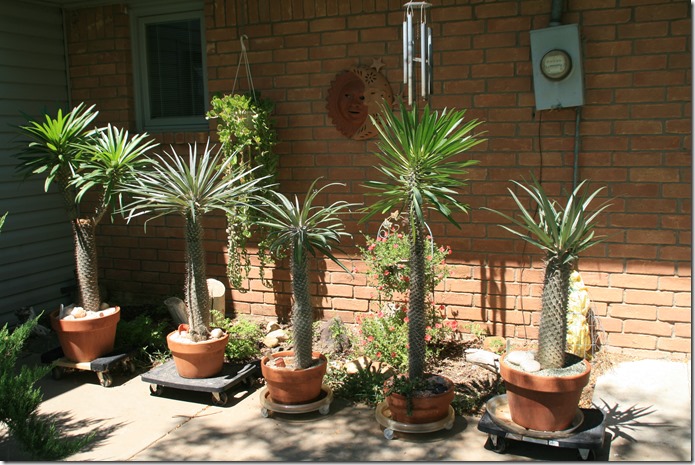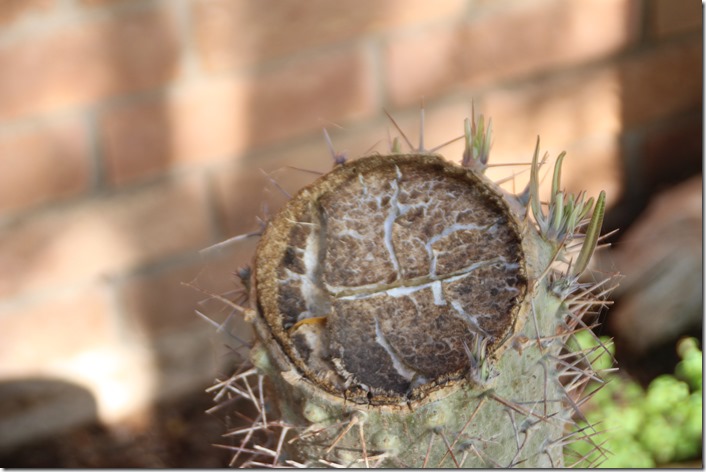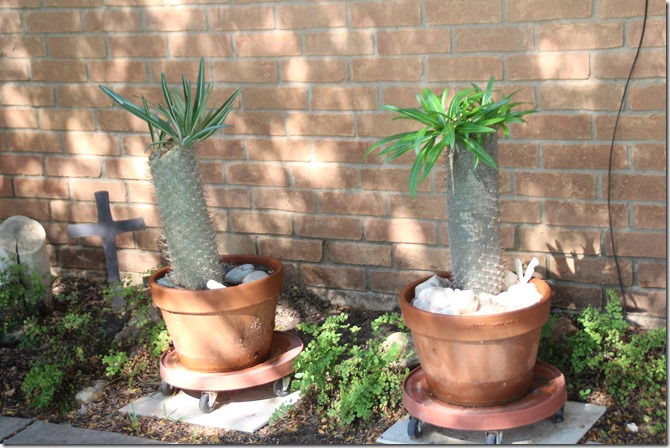In a blog post on July 18, 2012, I introduced you to the fat plants pachypodium geayi and p. lamerii, also known as Madagascar palms.
That was in 2012; by 2016 the two pachys I kept had grown a foot or more taller than me. They were outside this Spring when we had especially hard West Texas winds that just shredded the leaves. They looked pitiful! The fact that they looked so ragged, and the fact that they were so tall their pretty crowns went unseen and appreciated, I knew the only fix would be ruthless pruning. After all, they still had to fit through the door to come inside when winter cold hit, and it would take a whole season for the tops to look even halfway good, and maybe not even then. So I took out my trusty pruning saw and went to work. This is what they looked like after I finished;
Not much to look at, right? But they were not much to look at before, either. This picture was taken in May. Over the next few weeks I looked at them from time to time, kept them watered, and waited for signs of regrowth. And finally, on June 29th, I looked, and then looked again, up close. There they were, the first little nubs of new crowns, new growth around the edges of the cut trunks. See the little spot of lime green? Several of those were coming out all around the trunks on both plants.
By August 3rd they looked like this:
And by the first of September they looked like this:
On the left is pachypodium geayi, which has a longer, slender leaf with a stripe down the middle. On the right is p. lamerii with a shorter, wider leaf that is a bit softer than p. geayii, is a brighter shade of green and has a paler stripe down the middle of the leaf. I counted five crowns on p. geayi and nine on p. lamerii. These crowns will become branches, and by next summer these trees will look completely different. Go back and look at the first plant on the left, which I pruned a couple of years before the picture was taken. That will give you an idea what these will look like after a year or so, only they will have even more branches and be fuller and pretty and happy with their new look. And I will be happy with their new look.
Pruning cures a multitude of ills. Don’t be afraid to try it.








Top cuttings are easy to root during warm weather. A lot of people root and keep the top, and sell or give away the bottom. You can also let the bottom sprout, and take those off when they get big enough to root on their own.
I haven’t had much luck rooting the tops, but good for you if it works! It’s worth a try.
Please elaborate on rooting the tops. In detail thanks as I am about to try and would like it to be a success. Thanks
John, I fear I have not had much luck rooting the tops of pachypodiums, either! I can tell you to do it during their growing season, which I find to be in the spring here, and to use a very young, green part of the stem. I have heard the experts say these tops are very hard to root, so you may have to shed a tear and just throw them away. I will do some research and ask some questions and write a blog about it if I find a good way to do it. Thanks for reading.
Did you need to cover the “open wound” to protect it from rain?
I did not cover mine, Christina, and I don’t think you need to. But then, where I live, it doesn’t rain much, so I wasn’t concerned! But, really, unless it is raining when you cut it, the cut will dry quickly and be fine.
I am getting ready to cut mine… it is about 7 ft tall. Very nervous…thinking about rootone on base of top to try to root… any ideas ?
I have never used rootone when I cut mine, and they came out fine; can’t give you any guidance on that. Mine are putting on new growth right new leaves, right now, so this might be a good time to prune, but I usually try to wait and cut mine in the spring. I suspect it will work any time of year, except maybe the dead of winter. Be patient and good luck!
Hi Alice, I think Peter is asking about Rootone on the upper portion of the plant that is cut off. You said up above you have not had success rooting those, has that changed?
I have not tried the Rootone, nor have I tried to root any more of the tops, mostly because I haven’t pruned the palms back again, but also because I really have no room for another one! Not the answer you were looking for, I know. I have been told the best time to try to root them is when they are putting on new growth, but other than that suggestion, I’m afraid I am no help! And just because I have not had any luck doing it, that doesn’t mean you won’t be successful. Keep trying.
Hi Alice, I live in Southern Spain near the coast so pretty good weather condition but I have a very sorry looking Madagascar Palm in my garden. Its trunk is an orange yellow colour but not mushy at all, just a strange colour. It has no leaves and I have no idea what is wrong with it. Its in a sheltered position in full sun most of the day and on a drip irrigation system. The other succulents in the same bed look great. Any ideas Alice?
Oh, goodness, Amanda, I’m afraid I’m not that much of an expert on Madagascar palms! Even though your other succulents seem okay in the drip irrigation, perhaps the palm needs to dry out between waterings. When plants turn yellow, it is sometimes because of lack of iron, so you might try giving it a light dose of iron or plant food with some iron in it. If you do feed it, make it a light dose and don’t do it if the dirt is bone dry-you don’t want to burn the roots. If it has lost all its leaves, it may be slowly dying, and you may not be able to stop the inevitable. If you cut it back like I did mine, you will be able to see if the tissue inside looks healthy and give it time and maybe it will come back out for you. I wish I could give you better information; I hope you don’t lose the plant. But, sometimes we do lose one, no matter how hard we try to keep it going. If you lose it, try again with another palm. Hope this helps.
Not sure if anyone still follows this, but my Madagascar caught a nasty case of rot near the top after a bug infested it this summer. It was the very tippy top and it even shot a leafy bud out lower down, so I took that as a sign it needed that small rot cut out. It was a 5 foot tall plant, heavy as all heck and a pain (literally) to transport inside to its sunny window in the winters. This year, I tool just the top off, until I got to fresh green woody trunk. I dusted with cinnamon and hoped for the best. Well, to my extreme dismay (Ive had this plant since my daughter was born, she turns 13 next week) today I discovered the lowest part of the plant growing soft. Not mushy, but not woody either. Is my plant dead? Can I do anything? Would the middle survive? The trunk is still woody further up, but about a foot at the bottom has just a bit of give when poked and I dont like it.
Do I have a funeral to plan?
If the plant is mushy near the bottom, I fear that yes, a funeral may be in the offing. And I know how you must feel about losing one you have had a long time. I really have no suggestions other than cut back on watering and don’t give up on it just yet. And give it as much sun as you can through the winter. I have one left and have had it since it was a six- inch baby about twenty years ago. I have pruned it back three times when it was too tall to get it through the door for the winter, and it has come back each time. But this last time it took a long time for it to sprout new crowns. Don’t give up on it, and good luck.